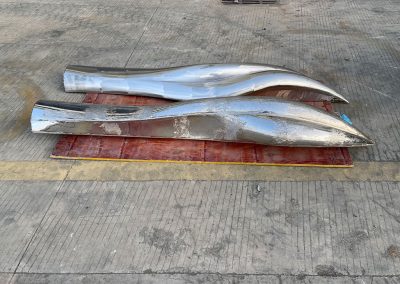In the past, he used flange bearings to make his sculptures, like his sculpture Gyre, spin. He would just use two flange bearings, one on the top and the other on the bottom. He had to get the two bearings perfectly lined up, which has always been one of his problems with flange bearings.
The other issue he’s had is illustrated by his sculpture Moonshine, in which the bearings are buried down inside the pedestal. But they had to be buried a couple of feet deep in that pedestal because they are so big and clunky.
Then Kevin discovered thrust bearings. The cool thing about thrust bearings is that they
have their own inner and outer races built into them. It also traps the needle bearings inside it. So it can spin, but not on itself.
With flange bearings, you have to bolt the bearings to the pedestal. Then it has an outer race with ball bearings and an outer race. It then twists and turns by itself, but one half is held firm.
Kevin shows a different thrust bearing, which has its own races, or washers, on it for the balls to run in. So it’s like an outer race, an inner race, and then a cage for the balls to run in.
That allowed him to use just one bearing on the top of the pedestal. The bearing went down over a shaft that was welded to the upper part of the sculpture. On the bottom of the sculpture, he welded another big washer – something big, heavy and flat that he cut out of plate steel with a hole saw.
Now his upper race has something to butt up against. Then he did the same thing on the pedestal side: a nice big, flat washer welded to a pipe that went down inside the pedestal.
The pipe’s inside diameter is the same as the outside diameter of the shaft that is welded to the upper part of the sculpture, giving it just a little clearance.
The thrust bearing sits on top of the washer on the pedestal, then the shaft fits down inside the pipe. You put a little grease on it, then fit the shaft down into the pipe, trapping the thrust bearing with the other washer, with everything held down with gravity.
The long shaft gives stability from side to side, and the thrust bearing, which is rated to about 3,000 pounds, handles the spinning part. “It spins so beautifully,” says Kevin. “It’s just beautiful to see.”
Then, to keep the dust, dirt and weather out, he put a collar between the upper part of the sculpture and the pedestal itself where the bearing is. To grease it, someone can lift up the upper part while someone else dabs some axel or other grease on the bearing. Then you’re good for another year or two.
There are different sizes of thrust bearings as well as different diameters, different thicknesses and different uses. Kevin says he imagines he’ll find some uses for them other than what they were intended for!
He’s ready to go back to work, but you might want to stick around one more moment to see Kevin flog a naughty metaphor ….

